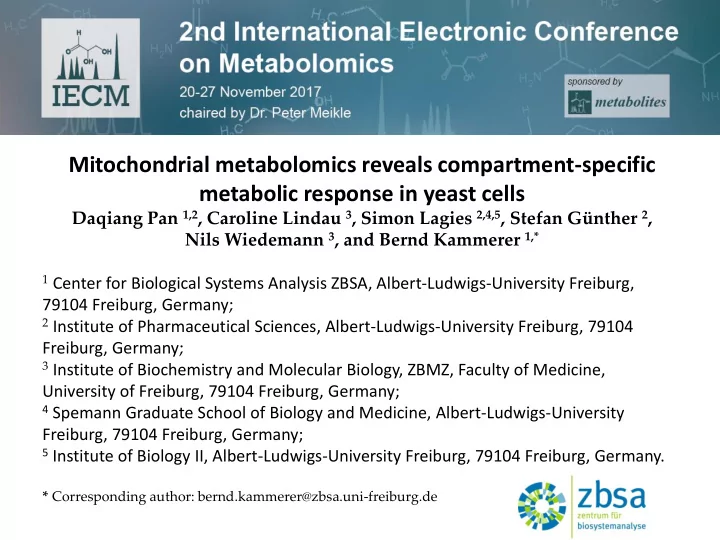

Mitochondrial metabolomics reveals compartment-specific metabolic response in yeast cells Daqiang Pan 1,2 , Caroline Lindau 3 , Simon Lagies 2,4,5 , Stefan Günther 2 , Nils Wiedemann 3 , and Bernd Kammerer 1,* 1 Center for Biological Systems Analysis ZBSA, Albert-Ludwigs-University Freiburg, 79104 Freiburg, Germany ; 2 Institute of Pharmaceutical Sciences, Albert-Ludwigs-University Freiburg, 79104 Freiburg, Germany ; 3 Institute of Biochemistry and Molecular Biology, ZBMZ, Faculty of Medicine, University of Freiburg, 79104 Freiburg, Germany; 4 Spemann Graduate School of Biology and Medicine, Albert-Ludwigs-University Freiburg, 79104 Freiburg, Germany; 5 Institute of Biology II, Albert-Ludwigs-University Freiburg, 79104 Freiburg, Germany. * Corresponding author: bernd.kammerer@zbsa.uni-freiburg.de
Mitochondrial metabolomics reveals compartment-specific metabolic responses in yeast cells 2
Abstract: Mutations in mitochondrial membrane proteins could cause physiological and metabolic alterations in mitochondria as well as in cytosol. In order to address the origin of these alterations, mitochondria and cytosol of yeast wild-type BY4741 and two mutants, sdh2 Δ and atp4 Δ, were isolated and analyzed by gas chromatography-mass spectrometry based metabolic profiling, identifying seventy-two metabolites altogether, from which sixteen or eight were either detected in cytosol or mitochondria. Compartment-specific distribution and regulation of metabolites were observed, showing the responses to the deletions of sdh2 and atp4. Based on the metabolic signature in mitochondrial matrix and cytosol, both mutants can be discriminated from wild-type by principal component analysis. Deletions of electron chain transport components, sdh2 and atp4, altered not only citrate cycle related metabolites, but also diverse metabolites including amino acids, fatty acids, purine and pyrimidine intermediates and others. By applying metabolomics to isolated mitochondria and cytosol, compartment-specific metabolic regulation can be identified, which is helpful in understanding the molecular mechanism of mitochondrial homeostasis in response to genetic mutations. Keywords: Mitochondria; budding yeast; metabolomics; compartmentalization; SDH2; ATP4. 3
Introduction • Mitochondria play an important role in energy metabolism • Defects in mitochondria are linked to human diseases such as cancer, Alzheimer’s disease and diabetes 1-3 • Compartmentalization of mitochondria indicates potential compartment- specific metabolic signature, which is difficult to be observed due to the pool of metabolites in cytosol 4 • Isolation of mitochondria is necessary to reveal the compartment-specific metabolic alterations in response to the genetic defects • Yeast strains with loss of electron transport chain (ETC) components sdh2 or atp4 were applied together with wild-type (BY4741) in this study • Isolated mitochondria and cytosol were applied to GC-MS-based metabolic profiling 1 Gaude and Frezza 2014; 2 Paglia et al. 2016; 3 Priyadarsini et al. 2016; 4 Chen et al. 2016 4 4
Introduction Workflow 5 5
Results and Discussion Mitochondria were intact after the isolation After proteinase K incubation, Tom70 were depleted while Tim44 maintained, indicating the intact mitochondrial inner membrane 6 6
Results and Discussion Compartment-specific metabolic signature in mitochondria and cytosol of WT Seventy-two metabolites were identified altogether, from which eight or sixteen were only detected either in mitochondria or cytosol, indicating the compartment- specific distribution of metabolites. 7 7
Results and Discussion Metabolomics reveals compartment-specific metabolic response Heatmap, showing the fold change of metabolites in mitochondria and cytosol of atp4 ∆ and sdh2 ∆ cells • Loss of atp4 and sdh2 resulted in different metabolic responses. F umarate, malate, and citrate were depleted in mitochondria of sdh2 ∆ cells, while were maintained in atp4 ∆ cells. • Pyruvate and malate showed reverse regulation pattern in mitochondria and cytosol of atp4 ∆ cells. • Compartment-specific metabolites are shown in grey boxes (not detectable either in mitochondria or cytosol indicating the absence or low abundance of a metabolite). 8 8
Results and Discussion Metabolomics reveals compartment-specific metabolic response PCA plot and loading map • PC2 discriminate mitochondria from cytosol, while PC3 sdh2 ∆ from atp4 ∆ . • Loading map displays the distribution of metabolites based on PC-values and shows how the metabolites contribute to the discrimination • The most cytosol-specific metabolites have positive PC2 value, while mitochondria-specific negative • TCA intermediates malate, fumarate, citrate, and pyruvate have positive PC3 value and succinate has negative PC3 value 9 9
Results and Discussion TCA cycle is interrupted in sdh2 ∆ but maintained in atp4 ∆ cells Fold change of TCA intermediates and related metabolites sdh2 ∆ : accumulated succinate, decreased fumarate, and depleted citrate, malate indicate a interrupted TCA cycle in sdh2 ∆ cells atp4 ∆ : all detectable TCA intermediates were maintained or upregulated in mitochondria Accumulation of succinate is reasonable, as loss of atp4 interrupted ATP synthesis, resulting in accumulation of protons in intermembrane space and NADH in matrix. Consequently, complex II is inhibited due to excessive NADH. 10 10
Results and Discussion Accumulated NADH is exported from mitochondria to cytosol in atp4 ∆ cells through: Reversed malate-aspartate shuttle : • Malate is increased in mitochondria and concomitant decreased in cytosol • GOT1 has been described to reverse the flux upon ETC (Complex I and III) inhibition, generating aspartate from oxaloacetate in cytosol 5 • Therefore, it is highly possible that reverse malate-aspartate shuttle could be activated to export NADH 2-Hydroxyglutarate path : • 2-HG was in both mitochondria and cytosol accumulated • Formation and degradation of 2-HG was described to occur in cytosol, coupling the shuttling of reducing equivalents into mitochondria 6 • Accumulated NADH may trigger cells to export NADH by reducing 2-KG to 2-HG, which is then transported to cytosol 5 Birsoy et al. 2015; 6 Becker-Kettern et al. 2016 11 11
Conclusions • Mitochondrial metabolomics reveals compartment-specific metabolic response to genetic defects • Deletion of sdh2 strongly interrupted TCA cycle while ETC was only slightly affected • Deletion of atp4 interrupted ETC while TCA cycle was maintained 12 12
Acknowledgments 13 14
Recommend
More recommend